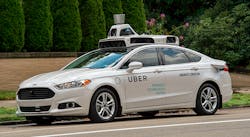Over the last three centuries, virtually all major technological changes had their genesis in the industrial sector. Think of the dramatic economic transformations since Adam Smith’s provocative explanation in 1776 of how free enterprise creates wealth. The introduction of the steam engine in the 18th century revolutionized our economy through mechanization and led to the building of steamships and railroads. Electricity in the latter half of the 19th century helped launch the mass-production economy, leading to a world of internal combustion engines and light bulbs and telephones. The advent of computers and automation in the second half of the 20th century led to a digitalized world. Manufacturing was the central player in each of these economic revolutions.
Today, service companies like Amazon, Uber, and Google are driving many of the most notable changes of the 21st century marketplace, and manufacturers are scrambling to keep up. True, today’s digital technologies were built on the shoulders of prior manufacturing successes. But just as others leveraged the innovations from the manufacturing revolutions of the past, manufacturers will now benefit from the service sector revolution of the present—by leveraging the innovations of these 21st century service behemoths.
How might this happen? Let’s start with the “Amazon effect,” a reference to the impact of the digital marketplace on traditional brick-and-mortar businesses. Amazon’s business model has revolutionized consumer expectations. People want clear choices with faster delivery at cheaper costs. To this end, Amazon has done more than any other company to jumpstart manufacturers’ foray into digital transformation.
One way the Amazon effect is altering business strategies: Roughly half of manufacturers in a JDA Software survey last year stated they were focusing on better "internal and external collaboration across the supply chain," and another four out of 10 said they were prioritizing inventory optimization. In other words, manufacturers are trying to gain full control of their supply chains.
They’re also trying to get better control of their distribution channels. As economist Michael Mandel observed in a 2018 MAPI report, Amazon’s transformation in distribution incorporated robotics and machine learning to improve the productivity of order fulfillment, “picking and packing” of individual items, and the best allocation of items across fulfillment centers. Thus, a digital future for manufacturing—one centered around what Mandel calls the “internet of Goods”—includes the rise of e-commerce fulfillment centers and the localization of distribution.
Along with the Amazon effect, there’s the “uberization” of manufacturing. Generally, the term describes converting services into discrete tasks that can be requested on-demand, particularly via an app. But it also refers to the globalization of supply points, stimulating both supply and demand.
Leveraging this could be as simple as on-demand manufacturing—companies connecting those who need machine time with manufacturers that have it. In addition, manufacturers are adopting the use of mobile devices to design, build, sell, and service products – in effect, orchestrating production and sales in real-time.
Uberization can also translate into managing a shop floor as a demand center. The “drivers” are multi-skilled technicians who can respond to on-demand service needs. Once a company runs a diagnostics test of its various shop floors, it can direct technicians to the machines that need servicing and even aggregate the feedback on service quality.
Finally, there is the “Googlization” of the factory sector. The term has occasionally been used pejoratively – see the book by that name, which professes we’re as much a product of Google as a customer – but in this case, googlization refers to the expansion in, and impact of, search technologies that incorporate the mass collection of data for commercial and industrial use. Think manufacturers can leverage this technology?
Of course they can--and already are. When properly utilized, the data manufacturers collect provides increasingly valuable information on the needs of their customers. But there’s a twist. Google tracks consumers’ virtual and physical meanderings and provides that data to third-party marketers as well as keeping a database of its own (there are, after all, about 3.5 billion internet searches a day). Manufacturers, on the other hand, are starting to track data on customers’ products, to enhance their ability to serve those customers’ needs. For example, Caterpillar’s extensive worldwide network of dealers allows it to aggregate data from all its machines and develop analytics that provide various solutions.
Yes, the service giants are driving today’s global marketplace upheaval. Still, manufacturers must leverage these changes to ensure it’s an industrial revolution as well.
Stephen Gold is president and CEO, MAPI (Manufacturers Alliance for Productivity and Innovation).
About the Author

Stephen Gold
President and CEO, Manufacturers Alliance
Stephen Gold is president and CEO of Manufacturers Alliance. Previously, Gold served as senior vice president of operations for the National Electrical Manufacturers Association (NEMA) where he provided management oversight of the trade association’s 50 business units, member recruitment and retention, international operations, business development, and meeting planning. In addition, he was the staff lead for the Board-level Section Affairs Committee and Strategic Initiatives Committee.
Gold has an extensive background in business-related organizations and has represented U.S. manufacturers for much of his career. Prior to his work at NEMA, Gold spent five years at the National Association of Manufacturers (NAM), serving as vice president of allied associations and executive director of the Council of Manufacturing Associations. During his tenure he helped launch NAM’s Campaign for the Future of U.S. Manufacturing and served as executive director of the Coalition for the Future of U.S. Manufacturing.
Before joining NAM, Gold practiced law in Washington, D.C., at the former firm of Collier Shannon Scott, where he specialized in regulatory law, working in the consumer product safety practice group and on energy and environmental issues in the government relations practice group.
Gold has also served as associate director/communications director at the Tax Foundation in Washington and as director of public policy at Citizens for a Sound Economy, a free-market advocacy group. He began his career in Washington as a lobbyist for the Grocery Manufacturers of America and in the 1980s served in the communications department of Chief Justice Warren Burger’s Commission on the Bicentennial of the U.S. Constitution.
Gold holds a Juris Doctor (cum laude) from George Mason University School of Law, a master of arts degree in history from George Washington University, and a bachelor of science degree (magna cum laude) in history from Arizona State University. He is a Certified Association Executive (CAE).
